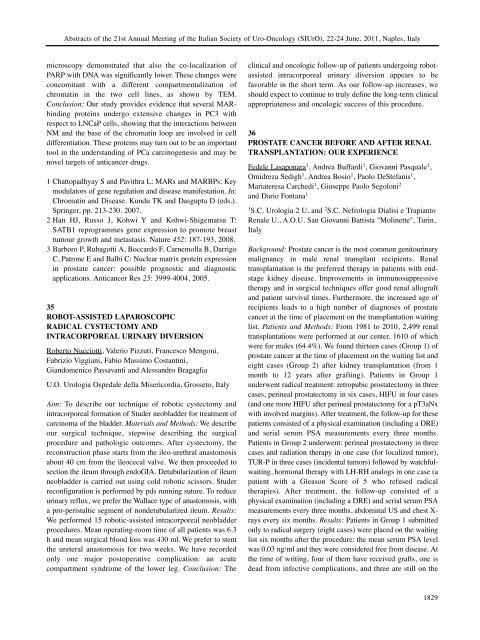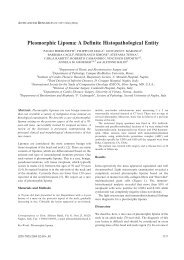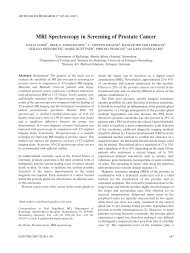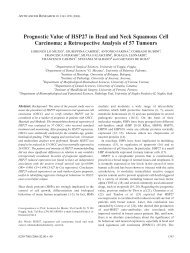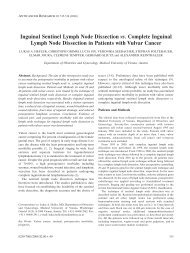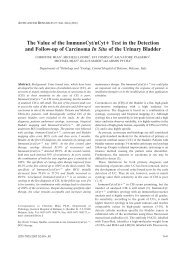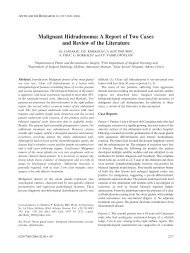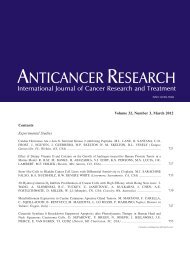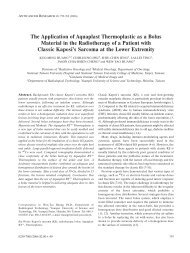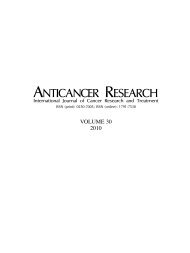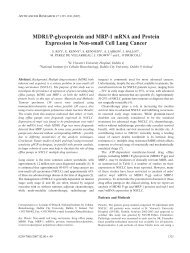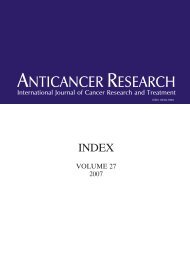ABSTRACTS OF THE 21st ANNUAL MEETING OF THE ITALIAN ...
ABSTRACTS OF THE 21st ANNUAL MEETING OF THE ITALIAN ...
ABSTRACTS OF THE 21st ANNUAL MEETING OF THE ITALIAN ...
You also want an ePaper? Increase the reach of your titles
YUMPU automatically turns print PDFs into web optimized ePapers that Google loves.
Abstracts of the <strong>21st</strong> Annual Meeting of the Italian Society of Uro-Oncology (SIUrO), 22-24 June, 2011, Naples, Italy<br />
microscopy demonstrated that also the co-localization of<br />
PARP with DNA was significantly lower. These changes were<br />
concomitant with a different compartmentalization of<br />
chromatin in the two cell lines, as shown by TEM.<br />
Conclusion: Our study provides evidence that several MARbinding<br />
proteins undergo extensive changes in PC3 with<br />
respect to LNCaP cells, showing that the interactions between<br />
NM and the base of the chromatin loop are involved in cell<br />
differentiation. These proteins may turn out to be an important<br />
tool in the understanding of PCa carcinogenesis and may be<br />
novel targets of anticancer drugs.<br />
1 Chattopadhyay S and Pavithra L: MARs and MARBPs: Key<br />
modulators of gene regulation and disease manifestation. In:<br />
Chromatin and Disease. Kundu TK and Dasgupta D (eds.).<br />
Springer, pp. 213-230. 2007.<br />
2 Han HJ, Russo J, Kohwi Y and Kohwi-Shigematsu T:<br />
SATB1 reprogrammes gene expression to promote breast<br />
tumour growth and metastasis. Nature 452: 187-193, 2008.<br />
3 Barboro P, Rubagotti A, Boccardo F, Carnemolla B, Darrigo<br />
C, Patrone E and Balbi C: Nuclear matrix protein expression<br />
in prostate cancer: possible prognostic and diagnostic<br />
applications. Anticancer Res 25: 3999-4004, 2005.<br />
35<br />
ROBOT-ASSISTED LAPAROSCOPIC<br />
RADICAL CYSTECTOMY AND<br />
INTRACORPOREAL URINARY DIVERSION<br />
Roberto Nucciotti, Valerio Pizzuti, Francesco Mengoni,<br />
Fabrizio Viggiani, Fabio Massimo Costantini,<br />
Giandomenico Passavanti and Alessandro Bragaglia<br />
U.O. Urologia Ospedale della Misericordia, Grosseto, Italy<br />
Aim: To describe our technique of robotic cystectomy and<br />
intracorporeal formation of Studer neobladder for treatment of<br />
carcinoma of the bladder. Materials and Methods: We describe<br />
our surgical technique, stepwise describing the surgical<br />
procedure and pathologic outcomes. After cystectomy, the<br />
reconstruction phase starts from the ileo-urethral anastomosis<br />
about 40 cm from the ileocecal valve. We then proceeded to<br />
section the ileum through endoGIA. Detubularization of ileum<br />
neobladder is carried out using cold robotic scissors. Studer<br />
reconfiguration is performed by pds running suture. To reduce<br />
urinary reflux, we prefer the Wallace type of anastomosis, with<br />
a pro-peristaltic segment of nondetubularized ileum. Results:<br />
We performed 15 robotic-assisted intracorporeal neobladder<br />
procedures. Mean operating-room time of all patients was 6.3<br />
h and mean surgical blood loss was 430 ml. We prefer to stent<br />
the ureteral anastomosis for two weeks. We have recorded<br />
only one major postoperative complication: an acute<br />
compartment syndrome of the lower leg. Conclusion: The<br />
clinical and oncologic follow-up of patients undergoing robotassisted<br />
intracorporeal urinary diversion appears to be<br />
favorable in the short term. As our follow-up increases, we<br />
should expect to continue to truly define the long-term clinical<br />
appropriateness and oncologic success of this procedure.<br />
36<br />
PROSTATE CANCER BEFORE AND AFTER RENAL<br />
TRANSPLANTATION: OUR EXPERIENCE<br />
Fedele Lasaponara1 , Andrea Buffardi1 , Giovanni Pasquale1 ,<br />
Omidreza Sedigh1 , Andrea Bosio1 , Paolo DeStefanis1 ,<br />
Mariateresa Carchedi1 , Giuseppe Paolo Segoloni2 and Dario Fontana1 1S.C. Urologia 2 U. and 2S.C. Nefrologia Dialisi e Trapianto<br />
Renale U., A.O.U. San Giovanni Battista "Molinette", Turin,<br />
Italy<br />
Background: Prostate cancer is the most common genitourinary<br />
malignancy in male renal transplant recipients. Renal<br />
transplantation is the preferred therapy in patients with endstage<br />
kidney disease. Improvements in immunosuppressive<br />
therapy and in surgical techniques offer good renal allograft<br />
and patient survival times. Furthermore, the increased age of<br />
recipients leads to a high number of diagnoses of prostate<br />
cancer at the time of placement on the transplantation waiting<br />
list. Patients and Methods: From 1981 to 2010, 2,499 renal<br />
transplantations were performed at our center, 1610 of which<br />
were for males (64.4%). We found thirteen cases (Group 1) of<br />
prostate cancer at the time of placement on the waiting list and<br />
eight cases (Group 2) after kidney transplantation (from 1<br />
month to 12 years after grafting). Patients in Group 1<br />
underwent radical treatment: retropubic prostatectomy in three<br />
cases, perineal prostatectomy in six cases, HIFU in four cases<br />
(and one more HIFU after perineal prostatectomy for a pT3aNx<br />
with involved margins). After treatment, the follow-up for these<br />
patients consisted of a physical examination (including a DRE)<br />
and serial serum PSA measurements every three months.<br />
Patients in Group 2 underwent: perineal prostatectomy in three<br />
cases and radiation therapy in one case (for localized tumor),<br />
TUR-P in three cases (incidental tumors) followed by watchfulwaiting,<br />
hormonal therapy with LH-RH analogs in one case (a<br />
patient with a Gleason Score of 5 who refused radical<br />
therapies). After treatment, the follow-up consisted of a<br />
physical examination (including a DRE) and serial serum PSA<br />
measurements every three months, abdominal US and chest Xrays<br />
every six months. Results: Patients in Group 1 submitted<br />
only to radical surgery (eight cases) were placed on the waiting<br />
list six months after the procedure: the mean serum PSA level<br />
was 0.03 ng/ml and they were considered free from disease. At<br />
the time of writing, four of them have received grafts, one is<br />
dead from infective complications, and three are still on the<br />
1829


